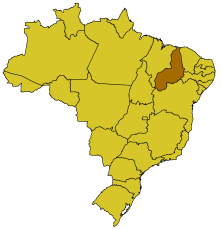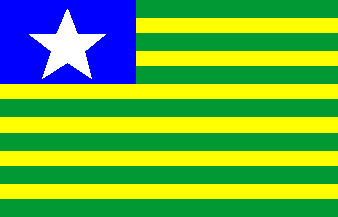|
|
| Statistics | ||
|---|---|---|
| Capital: | Teresina | |
| Area: | 250,934km² | |
| Population: | 2,750,000 | |
| Pop. density: | inh./km² | |
| Timezone: | GMT -3 | |
| ISO 3166-2: | ||
| Governor: | Wellington Dias (since 2004) | |
| Map | ||
 | ||
Piauí is one of the states of Brazil, located in the northeastern part of the country, in the arid region of Sertão.
Piauí is the poorest of all the Brazilian states, a situation that has been constant ever since the area was first colonised by the Portuguese in the 1600s. The state has practically no industry, and relies almost entirely on agriculture, primarily cattle farming, an attribute earning it the nickname 'the Leather Civilisation'. However, despite its rural-based economy, there is almost a perfect balance between the population living in the city, and those living in rural areas, something uncommon in Brazil.
The majority of the state has a semi-arid climate with wet periods from December to April and drought during the rest of the year. Much of the land in Piauí is caatinga, a type of scrub.
Piauí has the shortest coastline of any of the Brazilian states at 66km, and the capital, Teresina, is the only state capital in the north east to be located inland. The reason for this is because, unlike the rest of the area, Piauí state was first colonised inland and slowly expanded towards the ocean, rather than the other way around.
History
The state has many highly important archaeological sites, including the Capivara National Park, which is rich in remains of prehistoric Amerindian civilisations.
The first settlers in Piauí were bandits fleeing from São Paulo, notably Domingos Afonso Mafrense and Domingos Jorge Velho. Mafrense founded what is today Oeiras, whilst the first herds of cattle were taken there by Velho.
In the 1600s, many impoverished noblemen and Jesuit priests, as well as black and Amerindian slaves, settled there. The first large-scale cattle farming also arrived with these settlers. Large estate owners seeking new pastures for their livestock arrived from neighbouring states such as Bahia and Maranhão.
Teresina was the first Brazilian city to be planned. In 1852, an architect designed it, after being inspired by a chessboard. Situated at the mouth of the Parnaíba and Poti Rivers, Teresina was (and still is) known as the Green City because of the countless mango trees that line the city's streets.
Flag
The flag of Piauí was created on 24 July 1922. The blue canton and a star represents the state itself and the green and yellow bars represent Piauí's union with Brazil.
Other cities include:
External Link
Brazilian embassy in London's Piauí page (http://www.brazil.org.uk/page.php?cid=298)
| States of Brazil | 
|
|---|---|
| Acre | Alagoas | Amapá | Amazonas | Bahia | Ceará | Espírito Santo | Goiás | Maranhão | Mato Grosso | Mato Grosso do Sul | Minas Gerais | Pará | Paraíba | Paraná | Pernambuco | Piauí | Rio de Janeiro | Rio Grande do Norte | Rio Grande do Sul | Rondônia | Roraima | Santa Catarina | São Paulo | Sergipe | Tocantins | |
| Federal District: Brazilian Federal District | |

